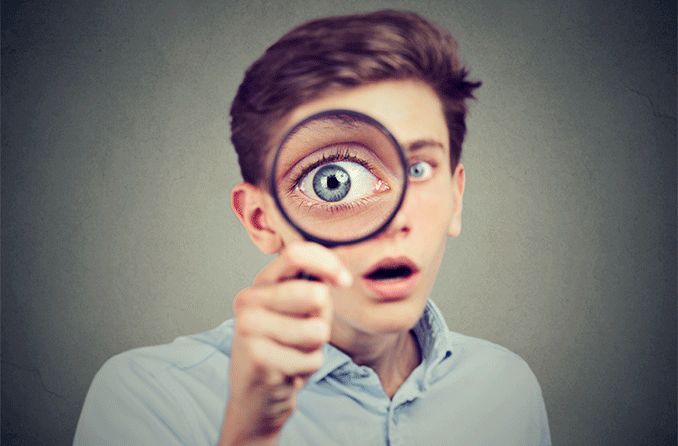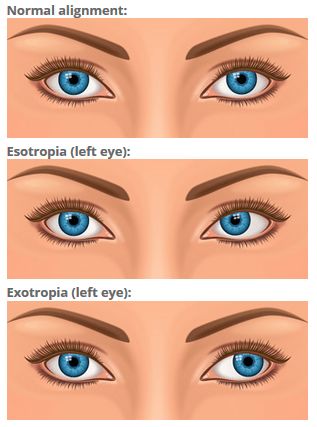Does poor vision change the appearance of your eyes?

Does poor vision make your eyes look different?
Poor eyesight can occur due to eye disorders, diseases and vision impairments. But do these problems cause the eyes to look any different? When it comes to refractive errors such as myopia, hyperopia and astigmatism, the outer appearance of the eyes does not change.
Instead, myopia (nearsightedness) and hyperopia (farsightedness) affect the length of the eyeballs, something your eye doctor can see during an eye exam. With myopia, the eyeball is longer than it should be, and with hyperopia, it’s shorter. And an eye with astigmatism has an imperfect curvature of the cornea or lens.
But even though refractive errors affect the eye’s structure and your ability to see clearly at certain distances, none of these errors make your eyes look outwardly different to you or other people.
Eyes may look different with strong glasses prescriptions
Severe cases of both nearsightedness and farsightedness can require strong vision prescriptions to correct your vision. And if you’re a glasses wearer, a strong prescription may mean a very thick lens.
Strong eyeglass prescriptions for farsightedness can make the eyes appear magnified or “bug-eyed.” It’s the opposite for strong nearsightedness prescription glasses, which can cause the eyes to appear small and “beady-eyed” behind the lenses.

The lenses in your glasses can cause your eyes to look bigger or smaller. This depends on the lens material used and the strength of your prescription.
To avoid these effects, you may want to consider aspheric eyeglass lenses, which are designed to reduce the undesired look of beady or magnified eyes behind glasses with a strong prescription. Contact lenses are also available for strong prescriptions and do not cause the eyes to appear bigger or smaller the way a thick eyeglass lens can.
Eye disorders that can affect the eyes’ appearance
While refractive errors may not obviously affect the look of your eyes, some conditions can make your eyes look different. These include eye alignment problems as well as diseases such as cataracts.
Eye alignment problems
Eye alignment problems such as amblyopia (lazy eye), strabismus (crossed eyes) and nystagmus (involuntary eye movement) can affect the appearance of the eyes.
Depending on the disorder, one or both of your eyes may look inward, outward, upward or downward. In some cases, one or both eyes may be fixated in one direction, while movement can be constant in others. This series of motions can make the eyes look different than eyes that normally look straight on.
Amblyopia (lazy eye)
In cases of amblyopia, one of the eyes does not reach normal visual acuity due to a problem with early visual development. This also makes the affected eye weaker. Lazy eye is not always apparent without an exam, but, in some cases, the weaker eye may wander inward or outward on its own, making it easier to spot.
Strabismus (crossed eyes)
Like amblyopia, strabismus is a condition that prevents the eyes from working together properly as a team. Strabismus may occur when someone is extremely farsighted or has poor eye muscle control. Eyes may look different in people with strabismus because of the way one of the eyes turns inward or outward from the other.
There are four variations of strabismus that can make eyes appear out of sync:

Esotropia — When one eye turns inward
Exotropia — When one eye turns outward
Hypertropia — When one eye turns upward
Hypotropia — When one eye turns downward
Nystagmus (involuntary eye movement)
Nystagmus is a disorder that causes repetitive and involuntary movements in one or both eyes. The condition makes it difficult for a person to stay focused on one object, and can cause them to have an irregular appearance.
Underlying conditions, trauma and various stimuli can all cause nystagmus. Some specific causes include severe refractive errors, cataracts, alcohol consumption and reactions to certain medications.
Each of these alignment disorders — amblyopia, strabismus and nystagmus — can also cause blurry vision and affect your depth perception.
Cataracts
A cataract occurs when the normally clear lens of the eye becomes clouded due to buildup and clumping of proteins. This can lead to poor eyesight and even vision loss.
Cataracts can also change the appearance of the eye, sometimes progressing to the point where the pupil of the eye appears milky white. This is a characteristic of what is called a mature cataract.
SEE RELATED: What do cataracts look like?
When to see a doctor
There are numerous other vision disorders that can change the appearance of the eyes. If you notice any difference in the way your eyes look or how well you can see, contact your eye doctor for an evaluation as soon as possible. And don’t forget to stay up to date on your yearly comprehensive eye exams.
Strabismus (crossed eyes). American Optometric Association. Accessed February 2022.
Page published on Tuesday, February 8, 2022
Medically reviewed on Wednesday, February 2, 2022






